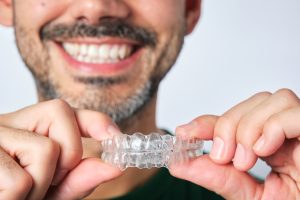Introduction
Teeth misalignment has been an age old dental issue that patients have wanted to address. Since the invention of modern braces in 1819 by Christophe-Francois Delabarre, there have been leaps and bounds in terms of innovation in the field of dentistry. While the function and the purpose of braces remain largely the same, modern and digital dentistry have found ways to achieve beautiful and healthy teeth for patients as quickly and effectively as possible. Today, there is a range of different types of braces available for those who want to achieve a perfectly aligned bite and avoid any of the potential health complications that might arise from badly misaligned teeth. To learn more about the most common different kinds of braces (and help determine which one would be right for you), read on in this comprehensive guide.
What are the 4 types of braces?
While there are several different types of braces for teeth that patients can consider (some of them still in the experimental stage), there are 4 primary types of braces that dentists and orthodontists most commonly recommend. These types can be defined as the following:
- Metal Braces – Metal braces are the most common method of teeth alignment that dentists prescribe to patients. Made of metal wires and brackets, traditional metal braces are attached to a patient’s teeth for a set duration of time, permanently installed throughout the course of treatment and requiring regular maintenance and adjustments. Although metal braces are the most common and usually most affordable alternative, there are still several downsides to choosing them as a patient’s preferred teeth alignment treatment. Because traditional metal braces are permanently attached to a patient’s teeth throughout the course of treatment, it can become difficult for patients to perform their usual dental hygiene routine amidst the brackets and wires getting in the way. This also requires patients to adhere to some food restrictions to reduce the risk of food particles getting stuck between their orthodontic gear. Apart from this, among the most common methods of teeth alignment, traditional metal braces are the most visually disruptive, leading to a drastic change in a patient’s appearance once they are installed.
- Ceramic Braces – Although ceramic braces function nearly identically to traditional metal braces, the key difference allows them to be more discreet than the previous option. Ceramic braces are made of ceramic material, which is more visually similar to the color of teeth, somewhat reducing the jarring shift in a patient’s appearance once they are installed. However, they still share the same downsides with metal braces and they cost significantly more because of the material that they are made of. Ceramic braces also require patients to undergo the same frequency of maintenance and adjustments as metal braces.
- Lingual Braces – Lingual braces share similarities with traditional metal braces because unlike ceramic braces they are made of the same material. However, the key difference is the placement of lingual braces, with wires and brackets being placed behind a patient’s dental arch instead of the front. Because they are out of the usual line of view, lingual braces are significantly more discreet than both ceramic braces and traditional metal braces. However, because it is a far less common method of alignment, it may be difficult to find a qualified dental professional who will be able to effectively assess, prescribe, and treat alignment issues using lingual braces. Apart from its limited availability, the placement of lingual braces are also less effective than traditional and ceramic braces. This means that while patients might have a more discreet experience throughout the course of their treatment, it will most likely also go on for much longer.
- Invisible Braces/Aligners – A departure from the brackets and wires approach from our initial three different types of teeth straightening, invisible braces (also known as clear aligners) are the most innovative method of teeth alignment available on the market today. Made from custom fit plastic trays that are clear and near invisible, not only are invisible braces incredibly discreet, they are also removable. This allows patients to remove them as needed, whether it is to eat or to maintain their oral hygiene routine–making them the method of teeth alignment that is the least disruptive for a patient’s lifestyle and usual diet. Because invisible braces apply pressure to teeth all across the dental arch in order to guide teeth to their proper place, they are also the option that achieves aligned teeth much quicker than other different braces. The only downside to invisible aligners is that treatment can be more expensive than other methods of teeth alignment. Invisible braces prices vary across different providers, so it is important to consider an expert provider that gives quality treatment with quality materials.

Which type of braces are the best?
Each of the different types of braces have their own pros and cons and whichever one you choose offers some degree of effectivity as they have been recommended by dentists for years. However, among the 4 types of braces, invisible braces are the clear best option, for a variety of reasons:
- They are nearly invisible. The material that invisible braces are made of is far more discreet than opaque metal or ceramic. This makes them significantly less conspicuous than the other options mentioned above, allowing patients to avoid a drastic change in appearance while getting closer to their goal of well-aligned teeth.
- They are removable. Clear aligners are inconspicuous while being non-intrusive, allowing patients to enjoy the benefits of teeth alignment without drastically having to change their lifestyle. Patients are free to eat, drink, and maintain their oral hygiene routine as they normally would throughout the course of treatment–all they have to do is remove the braces as needed and place them back on once they are done.
- They reduce the risk of oral hygiene problems during treatment. Because patients are able to effectively clean both their teeth and aligners during the course of treatment, patients who opt for clear aligners are at a lower risk of developing poor oral hygiene during alignment. This significantly reduces the risk of developing oral hygiene problems.
What type of braces work the fastest?
The placement of braces directly affects the effectiveness and duration of a patient’s alignment treatment. Ceramic braces and traditional metal braces have similar treatment times, while lingual braces often take longer to achieve alignment because the brackets and wires are placed behind the dental arch. Clear aligners on the other hand apply pressure all throughout the dental arch as the aligners are custom fit and designed to fit over the entire dental arch. Because of this, treatment using clear aligners lasts significantly shorter than treatment with other options.
Treatment with invisible braces can last between 10 to 24 months, but adult patients who have had braces earlier in life can achieve alignment even earlier. These special cases can take as little as 10 weeks. In order for treatment to be effective and for progress to be made, dentists recommend wearing the aligners for most hours of the day.
Why ALINA should be your choice when choosing among different types of braces
Today, how ALINA works is unique and innovative, helping patients achieve their most beautiful smiles that fit perfectly with the rest of their face. When choosing ALINA as your partner for uncovering your smile, you can expect:
- Better materials – Our invisible braces are made from a perfectly transparent, space-age material that’s FDA approved and completely hypoallergenic.
- Better technology – With AlinaSmile AI technology, ALINA takes into consideration all of your facial features to help you achieve your most beautiful smile.
- Better results – Over 25 years, ALINA has helped uncover the smiles of more than a million happy patients in the US, Canada, and the UK.
Start uncovering your smile and book a consult with Alina today.






